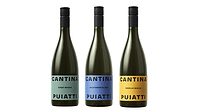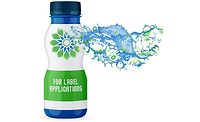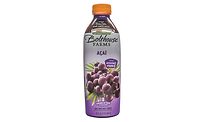Sustainability has growing influence on labeling materials for beverages
Specialty effects like inks, NFC technology and more proliferate label market

In the “Nature Cat” TV episode titled “Earth Day Every Day,” Nature Cat, Squeeks, Daisy and Hal learn through their journey to recycle a bottle that they found in a stream that by taking action Earth Day is every day. In the beverage market, brand owners and suppliers increasingly are embracing this mentality as they further sustainability initiatives.
Although much attention is given to primary packaging materials, suppliers in the labeling market are seeing the growing influence sustainability has on operations and are seeking to be proactive participants to the solution.
“Label suppliers are addressing sustainability trends by developing and offering label products to help beverage brands meet their packaging-related sustainability goals,” says Gwen Chapdelaine, marketing director for Fort Dearborn Co., Elk Grove, Ill. “Downgauging of label materials is one way to achieve these goals. This positively impacts the supply chain by delivering more labels per roll / bundle, and reduces changeovers and shipping weight.
“For paper labels, there are responsibly sourced papers (FSC, SFI, etc.) as well as papers that contain post-consumer waste,” she continues. “For labels being applied to PET containers, there are new developments including recyclable pressure-sensitive labels that easily separate from PET containers in recycling systems. For shrink sleeves, floatable, recyclable and deseaming are label options to support PET container recycling.”
Chapdelaine highlights the impact that downgauging has had in supporting recycling efforts as well as the vast number of label options from which to choose. “With many beverages being offered in plastic containers, there are now various labeling options to support recycling efforts,” she says.
Louis Iovoli Sr., vice president at Hammer Packaging, Rochester, N.Y., also highlights the influence of sustainability on the overall labeling market.
“Interest in sustainability has grown substantially, especially on PETE bottles, which continue to carry a significant value for reclaimed resin,” he says. “Consumers and brands alike are more environmentally conscious, opening the opportunity for converters like Hammer to be innovative and think differently about what we’re producing and the long-term impact that packaging has on the environment.”
Iovoli adds that Hammer Packaging works closely with substrate manufacturers to support sustainability efforts. “How the label interacts with the bottle during the recycling process has been mainly top of mind,” Iovoli explains. “For example, we’ve been working on innovative solutions for the pressure-sensitive label (PSL) and the shrink-sleeve label (SSL) segments of our business. The challenge with PSL is that once a traditional label is affixed to the bottle, the permanent adhesive prevents the label removal.
“Hammer Packaging offers a caustic-compatible solution that allows the printed label structure to be easily separated from the bottle during the recycling process,” he continues. “We offer a number of options for shrink-sleeve labels. One allows a typical PETE bottle to be recycled with the film using a similar resin composition. We also have a film that automatically diverts away from the bottle during a caustic wash as well as an option that interacts with innovative technology to automatically remove the label from the bottle. Developments have also been made on materials that have recycled content, which allows brand owners to position themselves more uniquely in marketing their sustainable product packaging.”
Effective effects
As consumers opt for more premium products, label suppliers are ensuring their products can support the transition.
“The drive toward premium beverages has corresponded to [the] use of more premium labeling materials such as film and specialty papers,” Fort Dearborn’s Chapdelaine says. “There are many choices available including clear films, uncoated papers and even wood veneer substrates.”
Hammer Packaging’s Iovoli adds that the competition on store shelves is prompting beverage-makers to utilize label features to help brands stand out.
“[T]he use of specialty coatings and inks has become a common request among our customers,” he says. “A tactile coating or matte and gloss combination can be the difference between a consumer picking up your brand over the next competitor on the shelf.”
Iovoli notes that the company has found that surface coatings have enjoyed recent popularity, mainly because of the wide variety available.
“We partner with our customers to find the most unique and effective solutions to ensure their products are standing out on the shelf,” he says. “For example, soft touch coating is a prime example of a product that enhances the overall brand as it tends to give the product a more premium look and feel. Matte coatings and varnishes, combined with spot UV, is a popular effect and generates a tactile component to the container. The ultimate goal is for our customers to achieve success on the shelf and we’re committed to finding that solution.”
Fort Dearborn’s Chapdelaine also details the impact that specialty effects can offer to beverage labels.
“Aside from the different materials that can be used, inks, coatings and finishing options are another way to make labels more impactful, including digital printing with personalization and variable imaging; fluorescent; foil; frosted; glow-in-the-dark; matte; metallic effects; pearlescent; scented; soft touch; tactile / texture; and thermochromatic,” she says. “Motion effects can also be used with color shifting, holographic, motion coat and even lenticular labels, which add dimension and motion to really make labels stand out on shelf. Another option is through the use of promotional labels such as instant redeemable coupons, extended content booklets and hang tags.”
Chapdelaine prognosticates that the beverage market will see an increase in the use of digital printing allowing for mass customizations, limited-edition products and short-run SKUs. This is just one of the ways that brands can use labels to connect with consumers, she says.
“Other ways beverage companies can connect and engage with consumers is through the use of QR codes, digital watermarking, [near-field communication] (NFC) or conductive inks on their packaging to enable a more interactive experience,” she adds.
Structured selections
With beverage labeling, brand owners have a plethora of attributes to consider when deciding which label material to utilize.
“All packaging follows the basic rule of ‘form and function,’” Hammer Packaging’s Iovoli says. “Label material selection is scrutinized against these requirements. To determine functionality, we need to understand how the material will perform during application and post application given the conditions it will be exposed. To ensure we’re selecting the right form, we ensure that the material can enhance the brand.”
When deciding which label material to use, Iovoli says the packaging buyer should consider the following items:
- What messaging they want to convey;
- How the package should interact with the consumer;
- What the end-use of the product is;
- What conditions does the product need to withstand; and
- Does the container need to reflect any sustainable packaging solutions?
To serve its beverage customers, Hammer Packaging offers a multi-print platform with numerous label styles, Iovoli notes. “We run a wide range of materials from papers to shrinkable films and foam,” he says. “There is no design or materials we wouldn’t try to help our customers achieve success on the shelf.”
Fort Dearborn’s Chapdelaine also highlights the impact that physical elements can have on product and packaging efficacy and how certain label materials can support those goals.
“For many beverage applications, companies are often looking for materials that offer water resistance, which are available in film options as well as wet strength papers,” she says. “Cut and stack, pressure sensitive, roll-fed, shrink and stretch sleeves are all available in film options. For shrink sleeves, white film is available that is naturally white, reducing the need for printed white coverage or color bottles and provides functional light barriers (UV and visible light) for increased product shelf life.” BI
Looking for a reprint of this article?
From high-res PDFs to custom plaques, order your copy today!






